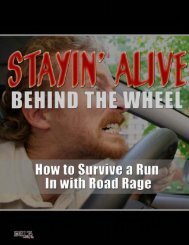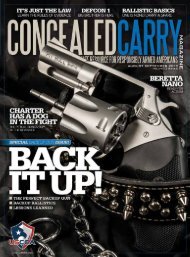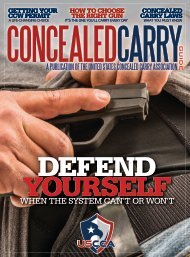Download This Issue - US Concealed Carry
Download This Issue - US Concealed Carry
Download This Issue - US Concealed Carry
Create successful ePaper yourself
Turn your PDF publications into a flip-book with our unique Google optimized e-Paper software.
above and right: It is easier to draw<br />
from an appendix position.<br />
mum chaos. We have noticed that the<br />
body naturally “figures things out” as<br />
you move. The old school method of<br />
keeping the support side hand and arm<br />
tight against the body, actually hinders<br />
dynamic movement. The support arm<br />
will act as a rudder of sorts enhancing<br />
your balance. If you need to turn your<br />
body, “flinging” the arm out will give you<br />
more momentum, allowing you to turn<br />
faster. Think of how a student of fencing<br />
uses his support arm to enhance his<br />
movement. The principles apply here<br />
as well. With an arm immobilized, you’ll<br />
sacrifice some balance and quickness.<br />
If it is in a sling, tight against the body,<br />
you lose your rudder.<br />
Now that we have an understanding<br />
of some the dynamics that will be involved<br />
in fighting with a hand or arm<br />
that is injured, it’s time to gas up the<br />
Airsoft pistol and run a few drills. We’ll<br />
be simulating injuries to the strong and<br />
support side hands and immobilizing<br />
the arms as well. What we want to do is<br />
realize how our bodies work when we<br />
take something out of the equation.<br />
The first scenario is an injured support<br />
hand. In order to concentrate on<br />
showing the techniques (instead of<br />
dealing with the problem of a live opponent)<br />
I used a static target instead<br />
of a real adversary. You can utilize the<br />
support hand to help control your over<br />
garment as you acquire your firing grip.<br />
As you present and move, your arm is<br />
still available to act as a counter-balance.<br />
The only technique not available<br />
to you is your two- handed grip. One<br />
thing you will want to keep in mind is<br />
that some angles of movement will be<br />
easier to utilize than others. For a right<br />
handed shooter, moving to the left will<br />
feel more natural. Moving to the right<br />
requires a transition to the support<br />
hand at some point fairly early on, but<br />
an injured hand or arm eliminates this<br />
possibility. If we completely immobilize<br />
the support arm, we find that our<br />
movement is affected to a degree. If<br />
your footing is a little bit unsteady, you<br />
won’t have the other arm to act as your<br />
counter-balance. As you explode off the<br />
X, you’ll clear the garment, acquire your<br />
firing grip, and present the pistol to the<br />
target.<br />
In the second scenario, we trade sides<br />
to an injured strong side; the dynamics<br />
change. You will be using your less<br />
dexterous hand to present and shoot<br />
your pistol. <strong>This</strong> is where prior training<br />
will come in very handy. The more you<br />
practice with both sides of your body,<br />
the easier these techniques will be. As in<br />
the prior scenario, as you acquire your<br />
pistol and present to the target the injured<br />
hand can assist with clearing the<br />
garment. <strong>This</strong> movement will be more<br />
familiar to your more dextrous, more<br />
practiced strong side. Again, you sacrifice<br />
the possibility of the transition to<br />
the other hand. You will also experience<br />
the same issues with your movement as<br />
before.<br />
Bilateralism is something that we emphasize<br />
in all our advanced courses. You<br />
should be able to shoot from either hand<br />
with a pistol and from either shoulder<br />
with a long gun. Along with the possibility<br />
of an injury prior to or during a gun<br />
fight, you may need to shoot from cover<br />
or concealment that forces you to use<br />
your support side. Train both sides of<br />
your body. Someday, your life may depend<br />
on it. n<br />
44<br />
<strong>US</strong>CONCEALEDCARRY.COM n CONCEALED CARRY MAGAZINE n JULY 2008
















